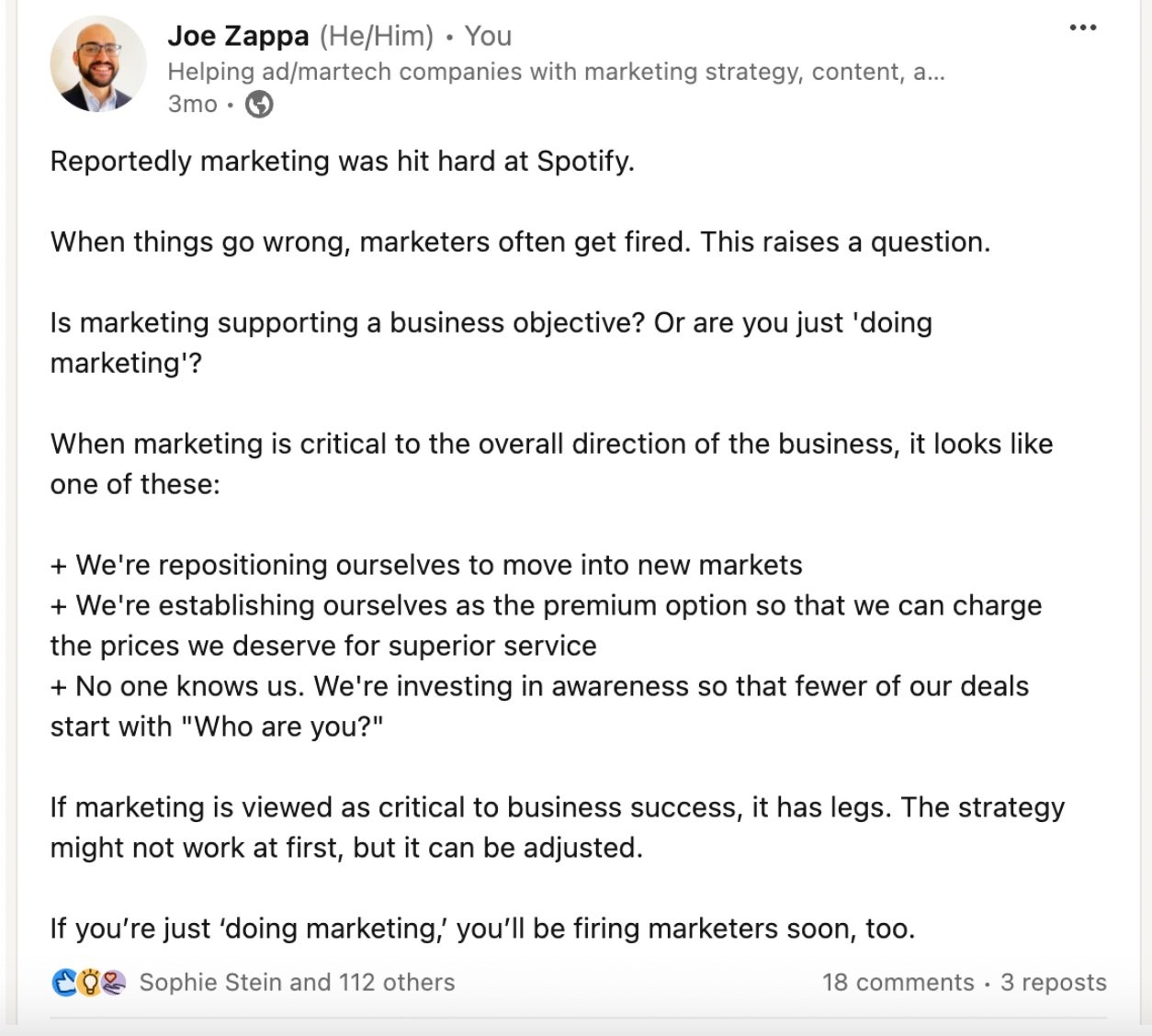Lessons from My 3 Most-Viewed LinkedIn Posts
I don’t think there’s an exact formula for creating effective social content. And my three most-viewed LinkedIn posts from the past 12 months reflect that — they are all very different. Analyzing high-performing posts should teach us something, though, about how to generate engaging content.
Here are the three posts as well as some analysis of the reasons they may have performed especially well.
If you’re in a rush, skip to the end. I summarize the 10 lessons I’d draw from these three posts.
Approach #1: Be the color commentator on industry news.
Lessons we might be able to draw from this post’s success:
In sports commentary, the color commentator is the one who doesn’t just summarize developments but analyzes or contextualizes them within the bigger picture. That’s essentially what I tried to do here — I took a specific development, mass marketing layoffs, and reflected on why marketers may get cut. In other words, try connecting newsy developments to broader industry problems.
Don’t just identify problems. Offer solutions. I argue that marketing is often viewed as inessential because there’s no strategy behind it. I also offer visions of what marketing looks like when it is strategic and essential to the business. This is more practical and educational than just being negative.
Post about stuff people actually give a shit about. Often companies get stuck in silos of invisibility because they’re just posting about what they do, and the sad truth is 90% of the people in their industry don’t care. Layoffs, though? Everyone cares about that because we’ve all been through it. If you have something thoughtful and differentiated to say about a topic everyone is thinking about, you’re more likely to gain traction.
Throw in some quips, especially about hot-button industry developments.
Lessons:
Don’t be afraid of humor. Like it or not, everyone is an entertainer these days. People who are top of mind and build relationships with their target audience win at business. Most of your posts should be thoughtful and more targeted than this (in my case, that means posting about adtech marketing). But some fraction of your posts should be broader to try to reach new people. Humor is a good way to do that.
Experiment with post lengths. Most of my LinkedIn posts are longer (maybe about ten sentences/lines). But sometimes the short ones hit, partly because they ask less of the audience. There’s no one ideal length for all posts.
Talk about the shiny new object, especially if you have a polemical take. I didn’t even intend this to be a post about AI, but that’s how many marketers took it (because the mediocre writing that humans have been doing forever is the standard for ChatGPT). Marketers are sick of people suggesting they can be replaced by AI (which writes clichés like the one I mention in the post), so they just had to jump in with comments.
Get personal, and share numbers.
Lessons:
Get personal, but also provide value. While people on the internet often suck, they also like to root for others. So, give them something to root for. But it’s even better if you can share your successes in a way that also provides value to the audience. In this case, I wrote about the growth of my business, but I did so while explaining to others who might emulate that success how it came about.
Share numbers. It fosters credibility and taps into voyeuristic impulses. Everyone’s curious about how much money their neighbor is making.
Make your advice digestible. Listicles have stuck around for a reason.
Be honest. It’s possible to talk about your success without making repeating it sound easy or engaging in hustle porn. My disclaimer, “My experience isn’t perfectly replicable,” helps in this regard.
In summary
Here are ten tips for creating content:
Tie news developments in your industry to big-picture problems; be the color commentator.
Identify solutions, not just problems.
Post about topics people already care about, not just whatever your company is doing.
Test humor.
Vary post lengths and formats.
Talk about shiny objects occasionally if you have a hot take on them.
Get personal while sharing lessons from your experience.
Share numbers.
Make your advice digestible.
Be honest, and try your best to be humble.



